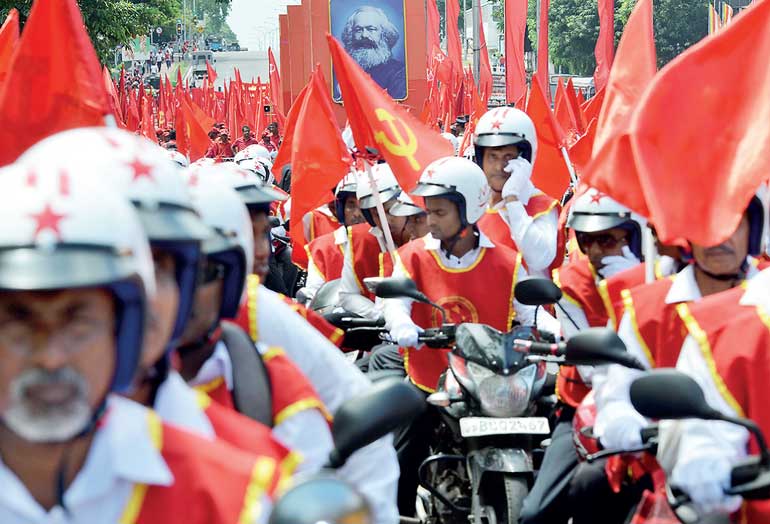Sunday Dec 14, 2025
Sunday Dec 14, 2025
Friday, 15 October 2021 00:00 - - {{hitsCtrl.values.hits}}

The role played by the JVP in pushing the Sinhala community into an anti-Tamil racist stance was immense. Similarly, the role played by the LTTE in pushing the Tamil community into an anti-Sinhala racist stance was equally immense. The damage caused to the socio-political system and economic system by the violent approach of these two insurgent movements and the similar approach adopted by the Government security forces to crush them is also immense – Pic by Shehan Gunasekara
 All major democratic concepts relevant to the modern state (individual freedom, social contract theory, limited
All major democratic concepts relevant to the modern state (individual freedom, social contract theory, limited
government, sovereignty, constitutionalism, secularism, equality before the law, separation of powers, etc.) can be considered as a legacy of liberalism.
It was in the 16th century that a philosophical dialogue on state began in the world. It could be considered as a dialogue that led to a successive wave of revolutions in Europe against the rule of authoritarian monarchies (the British Revolution of 1688, the American Revolution of 1776 and the French Revolution of 1789).
Classical liberalism can be described as a philosophy that was conceived and nurtured by this dialogue and the revolutionary process that ensued.
Not being liberal
In the sense of democracy, the decline and distortion of the system of governance and the political culture in Sri Lanka appears to have been mainly caused by the fact that both aspects were nurtured by feudalistic and Marxist ideas, ignoring liberal values and concepts.
There was a significant number of Marxists among Sri Lankans who received a higher education in Europe and returned to the country during the times when Sri Lanka found entry to the modern age prior to independence. However, there was not a single liberal among them.
But it was the reverse that happened in India. There was a large group of liberals (including Mahatma Gandhi) among those who went to Europe for higher education and later returned to India. There the Marxists constituted only a small group.
The Indian independence struggle moved forward through a liberal philosophical framework. Liberal ideas had a fundamental effect on the building of the Indian State and Nation as well as formulating the Constitution of India.
The situation in Sri Lanka with regard to liberalism was quite different. To date, not a single original book by liberal thinkers published in Sinhalese language. However, more than 50 original books on Marxism have been published in Sinhala. Sri Lankan youth in the ’70s and ’80s had a comprehensive knowledge of Russian, Chinese and Cuban revolutions which they knew by heart. But they did not know anything about the British, the American or the French Revolutions.
It was not through a freedom struggle that Sri Lanka gained independence; it was more a gift that Sri Lanka received from the British. This fact too, was an important reason contributing to the immaturity of the Sri Lankan leaders.
After independence, the lack of a liberal discipline had a significant negative impact on the rulers as well as society. The matters such as the issue of ethnicity, caste and religion, failure to govern the country in compliance with the Constitution and the inability to manage the country's economy and government budgets, optimally, occupied a major space among the areas which have been messed up.
It appeared clearly that the Tamil leaders like Chelvanayagam had a strong desire to pursue their struggle to win the rights of the Tamil people, particularly on the issue of deprivation of their language rights, within a non-violent and democratic framework.
The civil disobedience movement launched in 1961 in the north and east can be considered as the culmination of the struggle initiated to regain the language rights they were deprived of. To defeat the civil disobedience movement in the north and east which was pursued for 57 consecutive days, the Government of Sirimavo Bandaranaike that was in power arrested 51 Tamil leaders who led the campaign and detained them at the Panagoda Army Camp for 170 days.
Wijeweera and Prabhakaran
Even after this massive protest movement, the Government did not want to solve their language problem. Instead, after some time, the Government introduced a standardisation policy limiting the opportunity of Tamil students entering universities. These policies provoked the Tamil youth and pushed them to a situation in which they demanded a separate state.
The Sinhala youth in the south were the first to launch a violent struggle to seize State power. It was subsequent to that that the Tamil youth resorted to a similar program of violence. The Marxist theory of violent struggles had a discerning impact on these two rebellions of the Sinhalese and the Tamils.
On the other hand, the racial, caste and religious factors also had an impact on Sinhala-Tamil riots, in one way or other. The anti-Tamil and anti-Indian sentiment acted as a significant driving force of the JVP uprisings while anti-Sinhala sentiment acted as an equally strong driving force of the LTTE Tamil insurgency. There was another important feature in the insurrections launched by the Sinhalese in the south and Tamils in the north. The JVP uprisings in the south can be considered as two violent struggles fought between a rural youth movement with Marxist orientation, consisted of Sinhala Buddhists and largely non-Goyigama caste members and the Government security forces having a similar Sinhala Buddhist social background.
Another important feature that can be discerned in these two insurrections was the enormity of the volume of atrocities unleashed against each other despite the fact that the insurgents and the security forces that suppressed them were from the same social background.
On the other hand, despite the visible ethnic and religious differences between the two groups of insurgents as Sinhalese and Tamils and JVP and the LTTE, there were striking similarities also between the two groups in terms of their social background.
Wijeweera belonged to the Sinhala Karawa caste. Prabhakaran belonged to the Tamil Karayar caste. Gamanayaka, Wijeweera’s second in command at the JVP second insurrection, belonged to one of the lowest castes in the so-called Sinhala caste hierarchy.
Similarly, Tamilselvan, the second in command of Prabhakaran's LTTE movement, also belonged to a marginalised caste in the so-called Tamil caste hierarchy. The two parties may have had a hidden sympathy for each other, but in public they seemed to be having a bitter hatred.
Following the defeat of the JVP’s second insurrection by the security forces, the JVP had an acute hatred and contempt for the security forces. When the security forces had given up fighting the JVP and shifted its focus on fighting against the LTTE, the JVP became a movement that loved the security forces most.
Violent riots
The violent approach adopted by the JVP and the LTTE has made Sri Lanka an ugly State with a vicious and carnivorous image, and a country that depends on a huge security force, the size of which does not commensurate with that of the country while its maintenance cost is extremely high and has reached a level that the country cannot afford it any longer.
While the JVP as an organisation representing the majority Sinhala community was engaged in two unsuccessful attempts to seize State power of Sri Lanka through an armed struggle, the LTTE as a minority organisation engaged itself in a potent and fierce attempt to win a separate state instead of seizing control of the State of Sri Lanka.
The role played by the JVP in pushing the Sinhala community into an anti-Tamil racist stance was immense. Similarly, the role played by the LTTE in pushing the Tamil community into an anti-Sinhala racist stance was equally immense.
The damage caused to the socio-political system and economic system by the violent approach of these two insurgent movements and the similar approach adopted by the Government security forces to crush them is immense.
In making an assessment of the current state of collapse, the failure and bankruptcy of the country, it is important that the impact of fierce and violent activities of these two insurgent movements on it should not be overlooked because they have contributed immensely towards this eventuality in addition to the contribution made by anti-democratic and corrupt practices of those who have ruled the country since independence, particularly after 1978.
It can be said that not only the conventional political parties of the country, but also the militant political movements have played a significant role in dividing and fragmenting society on racist and religious lines. The lives of a large number of people in the Sinhala and Tamil communities were lost due to the ruthless crimes committed by these two insurgent movements; the cruelty unleashed on society in a competitive vein by insurgents as well as the security forces in combating the former had resulted in killing those who have survived, spiritually, to a greater or lesser degree and making the psyche of the society sick and distorted.
The damage done to the economy by both groups of insurgents in the long run is immense. It can be said that this situation has also affected the state of bankruptcy that prevails in the country.
We can consider how could the structural reforms needed to overcome the present crisis facing the country be won, in the next article.